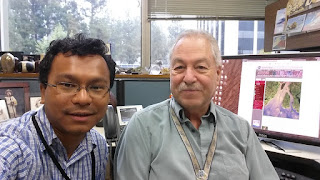By: Nancy Sheehan
A new summer course will allow incoming first-year students to get a jump on their journey into higher education at Worcester State University.
Called “Lancer Learning,” the free, three-credit course, which will run during Summer Session II, aims to bridge the gap between high school and college to help ensure students’ academic success. The course will be offered online in a flexible format so students will have a variety of ways to complete assignments and engage with faculty, current WSU students, and others.
Faculty leads will be Colleen Sullivan, Ph.D., associate professor of psychology, and Nabin Malakar, Ph.D., assistant professor of earth, environment, and physics. They will be assisted by a group of faculty, staff, and administrators who have volunteered their time to help with the course.
“It’s a multidisciplinary course that will talk about the expectations inside the classroom and open students up to Blackboard, our learning management system, which they’ve probably never used before,” says Tammy Tebo, M.Ed, assistant dean of academic services. “They’ll be getting critical feedback from professors on how they should be writing in college, and be taught learning strategies specific for first-year students.”
The course also will help incoming students build relationships with Worcester State faculty, staff, students, and administrators. “We want to provide them opportunities to gain more confidence and be better prepared to begin their first semester,” Tebo says.
Sullivan says she hopes the course will introduce students to important tools they can use once the fall semester starts and they officially become college students.
“What Nabin and I are trying to do is to incorporate the technology they will be using and identify some literacy resources so they can find the right tools they will need for their classes in the future,” she says. “We’re also going to work on having students start to experience learning at a college level so they can get a sense of the kinds of expectations that professors usually have.”
The course has been designed to position students for success over the next four years, Malakar says. “We want these students to excel at our university,” he says. “Given the new scenario of this pandemic, we want to make sure that our students are successful and well prepared for the upcoming fall semester.”
The concept for the course arose when President Barry M. Maloney set up safe reopening teams and asked one of them to focus specifically on what high school seniors coming to Worcester State in the fall might need.
“This year is very different than before because of the pandemic,” Tebo says. “These students have experienced a major disruption, so we hope this course will fill the gap of the information they might have lost since they’ve been out of touch and maybe haven’t held a pencil in a few months.”
The course will give enrollees social tools as well as academic ones, Sullivan says.
“Offering both academic and social support will alleviate some of the nervousness and anxiety that they might have about coming into a new environment,” she says. “They don’t know where to look for help, so sometimes they get a little lost and this class is designed to introduce them to some of those resources and show them where they are on campus. We hope that helps alleviate some of the first-semester jitters that they often experience.”
Course participants also will be able to get to know some of the people they will encounter when the fall semester begins. The larger group will be divided into smaller cohorts of 10 to 20 students at times, each working with its own group leader.
“Even though this is going to be online, they will be able to meet people, know a face, find somebody they have something in common with, so that even from a social perspective, it’s not as scary to them in the fall semester,” Sullivan says.
“We want to align students toward their future and familiarize them the tools that are available,” Malakar says. “We want them to make friends with the people that they’re going to be with, and to know that the professors are not the scariest people in the world, and that the Worcester State campus is a place where they can find all the resources they need.”
Tentative plans call for the course to be graded on a pass/fail basis. “Lancer Learning” will run in two segments. At some point between July 6 to 10, students will need to attend one virtual welcome event for enrollees. During this time, they will learn how to log in to BlackBoard (an online system where grades and assignments are posted), review course expectations, and meet our faculty.
From July 13 to Aug. 28, students will be expected to log in regularly and submit assignments on time. Each week, assignments and activities for the week will be posted on Mondays and due on Saturdays.
How to register:
An email has been sent to the Worcester State Gmail accounts of all incoming first-year students. In it, there is an electronic form to submit to enroll in the course. The deadline for enrollment is Friday July 3. Students can ask any questions by emailing asuccess@worcester.edu or their academic advisor.




